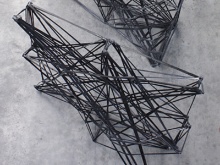LeichtbauBW Innovation Challenge
Explorative design tools for fibre-composite structures
Coreless-wound, robotically fabricated fibre-composite structures enable structurally optimized layouts of high-performance materials, while opening up new possibilities of design and construction of expressive lightweight structures. The underlying process of additive manufacturing allows for wasteless fabrication of large-scale, performative lightweight fibre components. Thereby, it provides for a ressource-friendly, efficient lightweight design of structures.
As load-optimized placing of high-performance materials illustrate its structural and performative requirements, the limiting factors to this general approach are the preexisting tools of design. Hence, the early stages of fibre structure research and design at the University of Stuttgart and FibR GmbH required project-specific physical prototypes, time-consuming digital-physical validation processes, while inadvertently minimizing the depth of exploration.
Fibrelous - the research outcome of a collaborative project from University of Stuttgarts’ Institute of Building Structures and Structural Design (ITKE - Prof. Jan Knippers), The Institute of Computational Design and Construction (ICD - Prof. Achim Menges), supported by FibR GmbH, as part of the LeichtbauBW-funded Innovation Challenge, integrates several sets of tools for fibre lightweight structure design, simulation and optimization into an automated workflow. It also considers multiple geometric conditions for said processes. Fibrelous, developed as a Rhino/Grasshopper plugin, allows for an explorative design process with coreless-wound hyperbolic shapes, and as a novelty, for space-truss fibre structures - augmenting the variety of high-performative fibre structures.
The workflow iteratively creates and validates fibre structures and reduces the time spent for physical-digital validation - and can be split into 3 main tasks:
1. Automated creation of fibre layouts including the simulation of material- and procedural behavior
2. Evaluation of fibre layouts with regards to its structural performance or additional user-defined parameters
3. Goal-oriented, iterative optimization of fibre structures, ensuring a closed iteration- and exploration loop
The underlying potential of Fibrelous allows for enhanced solutions of bespoke- and non-bespoke structures within a broad range of geometric variations. Due to software-based tools, low costs of development and novel building components, this set of tools aims to open up new fields of lightweight structure applications within a multitude of industrial sectors.
PROJECT TEAM
ICD Institute for Computational Design and Construction, University of Stuttgart
Christoph Schlopschnat, Prof. A. Menges
ITKE Institute of Building Structures and Structural Design
Drilon Gubetini, Bas Rongen, James Solly, Prof. J. Knippers
ASSOCIATED PROJECT PARTNERS
FibR GmbH, Moritz Dörstelmann, Ondrej Kyjanek
PROJECT FUNDING
LeichtbauBW Landesagentur für Leichtbau Baden-Württemberg,
Ministerium für Wissenschaft, Forschung und Kunst Baden-Württemberg
PROJECT INFORMATION
Christoph Schlopschnat, University of Stuttgart, Institute for Computational Design and Construction


